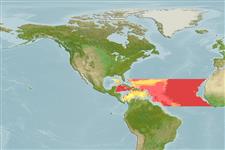>
Notacanthiformes (Halosaurs and deep-sea spiny eels) >
Halosauridae (Halosaurs)
Etymology: Aldrovandia: Taken from Ulisse Aldrovandi, (1522-1605), a Renaissance naturalist and physician noted by his systematic and accurate observations of plants and animals (Ref. 45335).
More on author: Günther.
Environment: milieu / climate zone / depth range / distribution range
Ökologie
seewasser bathypelagisch; tiefenbereich 2690 - 5029 m (Ref. 4448). Deep-water; 27°N - 5°N
Eastern Atlantic: Western Sahara and along the eastern slope of the Mid-Atlantic Ridge from 7°-5°N. Western Atlantic: off Bahamas and west of the Mid-Atlantic Ridge.
Size / Gewicht / Alter
Maturity: Lm ? range ? - ? cm
Max length : 50.8 cm TL Männchen/unbestimmt; (Ref. 4448)
Insertion of the pelvic fins well in advance of the origin of the dorsal fin. Separation of palatine tooth patches on the midline and disc-like lateral line plaques (Ref. 37108). Light colored, the lower part of the head and the gill cover black, abdominal region blackish. Lining of mouth is dark (Ref. 37108).
Inhabits the abyssal depths (Ref. 4448).
Life cycle and mating behavior
Maturities | Fortpflanzung | Spawnings | Egg(s) | Fecundities | Larven
Sulak, K.J., 1990. Halosauridae. p. 126-132. In J.C. Quero, J.C. Hureau, C. Karrer, A. Post and L. Saldanha (eds.) Check-list of the fishes of the eastern tropical Atlantic (CLOFETA). JNICT, Lisbon; SEI, Paris; and UNESCO, Paris. Vol. 1. (Ref. 4448)
IUCN Rote Liste Status (Ref. 130435)
Bedrohung für Menschen
Harmless
Nutzung durch Menschen
Tools
Zusatzinformationen
Download XML
Internet Quellen
Estimates based on models
Preferred temperature (Ref.
123201): 2.4 - 4.2, mean 2.7 °C (based on 276 cells).
Phylogenetic diversity index (Ref.
82804): PD
50 = 0.5156 [Uniqueness, from 0.5 = low to 2.0 = high].
Bayesian length-weight: a=0.00087 (0.00033 - 0.00229), b=3.07 (2.84 - 3.30), in cm total length, based on LWR estimates for this (Sub)family-body shape (Ref.
93245).
Trophic level (Ref.
69278): 3.5 ±0.50 se; based on food items.
Widerstandsfähigkeit (Ref.
120179): mittel, Verdopplung der Population dauert 1,4 - 4,4 Jahre. (Preliminary K or Fecundity.).
Fishing Vulnerability (Ref.
59153): Moderate vulnerability (40 of 100).
